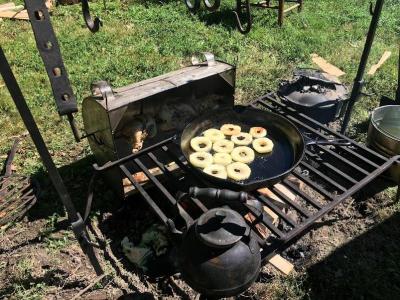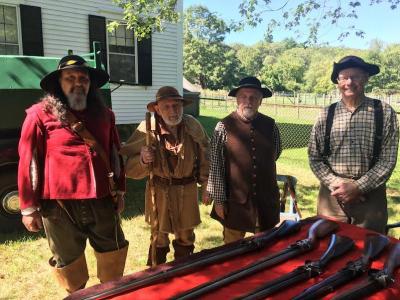Yesterday once more as Dartmouth celebrates heritage

The past was present Saturday, Sept. 11 at the annual celebration of Dartmouth’s heritage, held at the village schoolhouse headquarters of Dartmouth Historical Society.
Participants cooked, spun wool and even did laundry, all in the style of Dartmouth’s early years. The annual event is usually held in conjunction with the Grange fair, but that event was cancelled this year.
The activities celebrated the 150th anniversary of the schoolhouse, which was used from 1871 to 1914, and gave visitors a peek into an even earlier time.
Elizabeth Santos cleaned laundry using an early American washboard, then relied on a clothesline and fresh air to dry the clothes out.
The approach may not be as efficient as today’s methods, but Santos, a member of Girl Scout Troop 2019 in Westport and a Dartmouth resident and self-described history buff, enjoyed it more.
“Based on the amount of laundry I make, a washer-dryer is more practical,’’ she said with a smile. “But this is more fun. You’re able to do something with your hands, you feel like you’ve accomplished something.’’
Members of Spinners with Soule, a fiber arts group based at the Soule Homestead Education Center in Middleborough, displayed two early ways to spin fiber that still work today.
A drop spindle, a very basic method, spins and twists fibers into yarn, using a hook to guide the yarn and a disc called a whorl to weigh it down. A spinning wheel features a spindle driven by a wheel.
“We encourage the craft and we encourage young people to keep the heritage alive,’’ said Toni Souliere, who was demonstrating the spinning wheel while Barbara Chadwick worked on the drop spindle. “We live in a throwaway society. We lose so much of who we were and who we are.’’
Tea to Sea, a group that specializes in historical cooking, whipped up 18th century style apple fritters, which are more akin to today’s pancakes. They also roasted chicken, although the main course was slower to finish than the fritters.
This led to what some might consider a good problem, Leah Cairrao, dressed in early American garb, said. “We might have to have dessert first,’’ she said, laughing. “That works in any century.’’
Visitors could also interact with reenactors who reflected early American activities, including the early trapper trade and the King Philip’s War, an armed conflict in 1675-1678 between indigenous inhabitants of New England and New England colonists and their indigenous allies.
Many people do not even know about that war, reenactor Michael Cravinho said.
John Belcher, a gunsmith who created and displayed reproduction of arms from around that period, hopes their appearance will “keep history alive’’ and make people aware of early American history.
“Maybe they’ll do some reading and become enlightened,’’ he said.
Brian Santos, who presented a trappers’ camp replica, said the living history teaches live, in-person lessons. “This brings to the public how our forefathers lived and survived in this area,’’ he said.
That’s a vital lesson that is often missing today, said Chuck Clark, who depicted an early mountain man fur trapper. Education about America in the early 1700s is often lacking in today’s curriculum, he said. “They don’t teach that in school anymore,’’ he said.



















